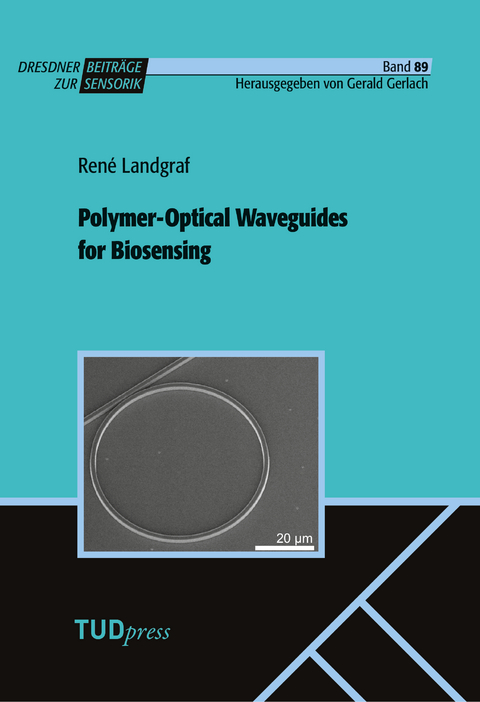
Polymer-Optical Waveguides for Biosensing
Seiten
2024
TUDpress (Verlag)
978-3-95908-324-9 (ISBN)
TUDpress (Verlag)
978-3-95908-324-9 (ISBN)
The reliable quantitative detection of biomarkers and pathogens at picomolar or even lower concentration is not readily available outside medical labs, yet, but would be a great help for point-of-need/point-of-care testing (POCT). However, such detection technologies are subject to extensive research. Microdevices based on integrated optical waveguides are candidates for the detection of such ultra-low biochemical concentrations.
In this work, sensors in the shape of microring or microracetrack resonators, manufactured by UV-assisted nanoimprint lithography (UV-NIL) as a promising but challenging replication technology, are investigated. Analytical and numeric models are developed and the main influence factors that allow a low limit of detection, such as the coupling gap width, the material shrinkage and the residual layer thickness, are identified and quantified. Potential biosensor applications are evaluated and general design rules as well as resulting designs are derived. The UV-NIL polymer and the more established silicon-based microresonators are compared in terms of technological parameters such as lithography resolution, integration level as well as the dynamic measurement range.
High quality factors of Q > 25 000 were reached for free spectral ranges of FSR = 1.3nm and of Q > 13 000 for FSR = 2.0 nm, allowing both a high resolution of the resonance shift detection and a sufficient dynamic range. The bulk refractive index sensitivity was measured to be (60 ± 4)nm/RIU (refractive index units) which was very close to the theoretical simulation of 63nm/RIU.
When comparing the results of this work to literature results, a very good sensor performance was accomplished: A high dynamic range together with a good bulk refractive index sensitivity was achieved for a technology with a fast throughput time. Regarding the possibility to further increase the sensitivities by one to two orders of magnitude through layout optimization and the fact that only two main manufacturing steps were necessary, the UV-NIL polymer waveguide technology of this work has a high potential for miniaturized, high-sensitivity biosensing.
Methods how to functionalize the microresonator sensors are tested and an alternative biosensor characterisation assay is suggested. Ideas how to integrate the microresonators into a biosensor system are investigated.
In this work, sensors in the shape of microring or microracetrack resonators, manufactured by UV-assisted nanoimprint lithography (UV-NIL) as a promising but challenging replication technology, are investigated. Analytical and numeric models are developed and the main influence factors that allow a low limit of detection, such as the coupling gap width, the material shrinkage and the residual layer thickness, are identified and quantified. Potential biosensor applications are evaluated and general design rules as well as resulting designs are derived. The UV-NIL polymer and the more established silicon-based microresonators are compared in terms of technological parameters such as lithography resolution, integration level as well as the dynamic measurement range.
High quality factors of Q > 25 000 were reached for free spectral ranges of FSR = 1.3nm and of Q > 13 000 for FSR = 2.0 nm, allowing both a high resolution of the resonance shift detection and a sufficient dynamic range. The bulk refractive index sensitivity was measured to be (60 ± 4)nm/RIU (refractive index units) which was very close to the theoretical simulation of 63nm/RIU.
When comparing the results of this work to literature results, a very good sensor performance was accomplished: A high dynamic range together with a good bulk refractive index sensitivity was achieved for a technology with a fast throughput time. Regarding the possibility to further increase the sensitivities by one to two orders of magnitude through layout optimization and the fact that only two main manufacturing steps were necessary, the UV-NIL polymer waveguide technology of this work has a high potential for miniaturized, high-sensitivity biosensing.
Methods how to functionalize the microresonator sensors are tested and an alternative biosensor characterisation assay is suggested. Ideas how to integrate the microresonators into a biosensor system are investigated.
| Erscheinungsdatum | 15.06.2024 |
|---|---|
| Reihe/Serie | Dresdner Beiträge zur Sensorik ; 89 |
| Verlagsort | Dresden |
| Sprache | englisch |
| Maße | 158 x 225 mm |
| Themenwelt | Technik ► Elektrotechnik / Energietechnik |
| Technik ► Umwelttechnik / Biotechnologie | |
| Schlagworte | Biosensoren • Detektion • Mikroresonator • Pathogene • TUDpress |
| ISBN-10 | 3-95908-324-6 / 3959083246 |
| ISBN-13 | 978-3-95908-324-9 / 9783959083249 |
| Zustand | Neuware |
| Haben Sie eine Frage zum Produkt? |
Mehr entdecken
aus dem Bereich
aus dem Bereich
DIN-Normen und Technische Regeln für die Elektroinstallation
Buch | Softcover (2023)
Beuth (Verlag)
86,00 €
Kolbenmaschinen - Strömungsmaschinen - Kraftwerke
Buch | Hardcover (2023)
Hanser (Verlag)
49,99 €


